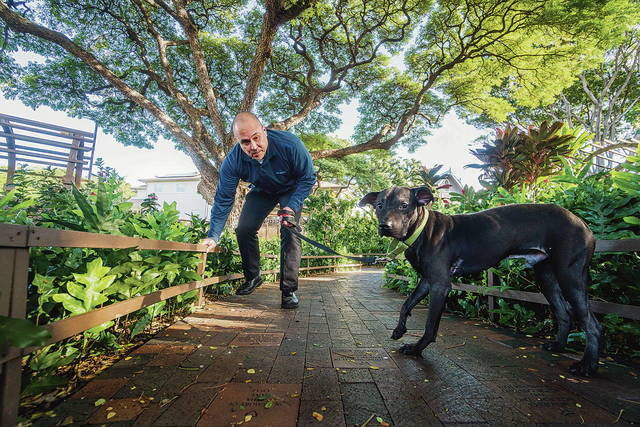Many prefer homelessness to living in a no-pets shelter

DENNIS ODA / DODA@STARADVERTISER.COM
Jenny Fong, once homeless, holds her pet dog, Kaimana, outside her temporary home, made from a shipping container, at Hale Maliola on Sand Island. Because of her dog, it is hard to find her permanent housing.

DENNIS ODA / DODA@STARADVERTISER.COM
Danny, a poi dog who was retrieved during a homeless sweep, on a morning walk with Harold Han, field services manager, on the Hawaiian Humane Society grounds.

COURTESY HAWAIIAN HUMANE SOCIETY
This is Danny, a poi dog who was retrieved along the bike path mauka of the H-1 viaduct during the Dec. 4 homeless sweep.



The Hawaiian Humane Society wants to find out how many pets are living among Oahu’s nearly 5,000 homeless people — and how their love of animals might be preventing them from getting housed.
Homeless pet owners consistently tell the Honolulu Star-Advertiser that they would rather remain homeless instead of abandon their animals to move into a shelter or a rental unit that doesn’t allow them.
“No, straight up no,” Jenny Fong, 51, said when asked whether she would ever give up her 10-year-old poi dog, Kaimana, to move into a homeless shelter or rental apartment. “It would be like giving up a part of myself.”
But Fong, husband Darryl and Kaimana moved out of their car a year ago when they learned that the city’s Hale Mauliola homeless “navigation center” on Sand Island accepted pets.
“That’s what’s so good about it,” she said at Hale Mauliola as Kaimana sniffed the ground outside the Fongs’ converted shipping container in an area reserved for pets and their owners.
Hale Mauliola and the U.S. Vets Waianae Civic Center are the only two emergency shelters on Oahu that take in pets, said Scott Morishige, the state’s homeless coordinator. Other shelters will accept service animals as long as the owner has proper documentation, Morishige said.
Don't miss out on what's happening!
Stay in touch with breaking news, as it happens, conveniently in your email inbox. It's FREE!
So the Hawaiian Humane Society hopes that the organizers of January’s nationwide homeless census, called the Point in Time Count, include a series of questions aimed at identifying how many pets Oahu’s homeless people have, what kind and whether they have played a role in keeping the owners homeless.
“We’re trying to understand how much a barrier pet ownership is for the homeless population and how we can remove some of that barrier,” said Lisa Fowler, president and CEO of the Hawaiian Humane Society.
Homeless survey
Pets, especially dogs, often generate complaints about homeless encampments when they bite or run at people, increasing calls to shut down and sweep the encampments.
Jen Stasch, director of Partners in Care, which is organizing the Oahu Point in Time Count, said a decision has yet to be made on whether to include any of the Humane Society’s questions when volunteers fan out across the island to count homeless people next month.
If the questions are included, the answers could lead to a campaign to get more homeless shelters to allow pets while encouraging private landlords to take a chance on renting their units to homeless people with animals.
“Generally speaking,” Stasch said, “any time you’re adding survey questions, you’re trying to understand the population we’re serving to do a better job.”
The issue over whether to include the questions involves the overall time that volunteers and social service workers can reasonably spend with each homeless person across Oahu and still conduct an accurate survey for the Point in Time Count.
Top in nation
The 7,220 homeless people counted across Hawaii in last year’s Point in Time Count represented the first decline since 2009 but still gave Hawaii the distinction of having the highest homeless rate in the country per capita.
Each year, the U.S. Department of Housing and Urban Development requires new questions, and “you don’t want to bombard somebody with 100 questions the first time you’re engaging with a person,” Morishige said.
But, Morishige said, “If animals are a primary barrier, that’s something that can help influence not only policy, but the services that are being offered. For a lot of people that are unsheltered, often they have an animal like a dog that provides not only companionship, but security when you’re living on the street. Like any pet owner, the bond is very strong, so people are often reluctant to part with their animals.”
Puppy mills
In some encampments, like the 120-person one under the H-1 freeway viaduct and the one in Kakaako that had more than 300 homeless people in 2015, some individuals owned dozens of dogs.
“One person under the viaduct had up to 60 dogs,” Morishige said. “In those cases it would be very, very difficult to find any type of housing accommodation for that many animals.”
Allison Gammel, spokeswoman for the Hawaiian Humane Society, said some homeless pet owners living below the viaduct acknowledged running puppy mill operations to sell their puppies to retailers.
“They were literally bringing handfuls of puppies out to us,” Gammel said. “They admitted they were selling them.”
Puppies are particularly susceptible to canine parvovirus, “which can run rampant through an encampment” and can be fatal, she said.
Like social service outreach workers, Hawaiian Humane Society staff and volunteers often visit homeless encampments weeks before an upcoming law enforcement sweep.
Two years ago they were typically met with a chilly, suspicious reception built on fear that the Humane Society wanted to seize their animals, said Harold Han, field services manager for the Hawaiian Humane Society.
“The hardest part is building trust, which takes a long time,” Han said.
Over the last two years, the Humane Society has provided free pet food, flea medication, leashes, collars, vaccinations, microchips, sterilization and medical exams to homeless encampments across the island — all funded through donations.
“We want to help them be successful pet owners in their situation,” Han said.
Danny
So when a sweep does occur, it’s often easier for a homeless person to surrender an animal to Humane Society workers and volunteers they know, Han said.
Last week Danny — a 2-year-old Shar-Pei mix — was still getting over his nervousness at the Humane Society.
During the Dec. 4 sweep of the Mapunapuna bike path that runs parallel to the H-1 freeway viaduct, Danny was discovered tied up and abandoned.
Even though his ribs were visible, Danny had outgrown his harness, which had dug into his skin.
A week later he had bulked up 10 pounds at the Humane Society but was still thin and weighed only 38 pounds. And he was still skittish and unsure.
So the plan is to place him in a foster home to get socialized, then eventually put him up for adoption, Gammel said.




